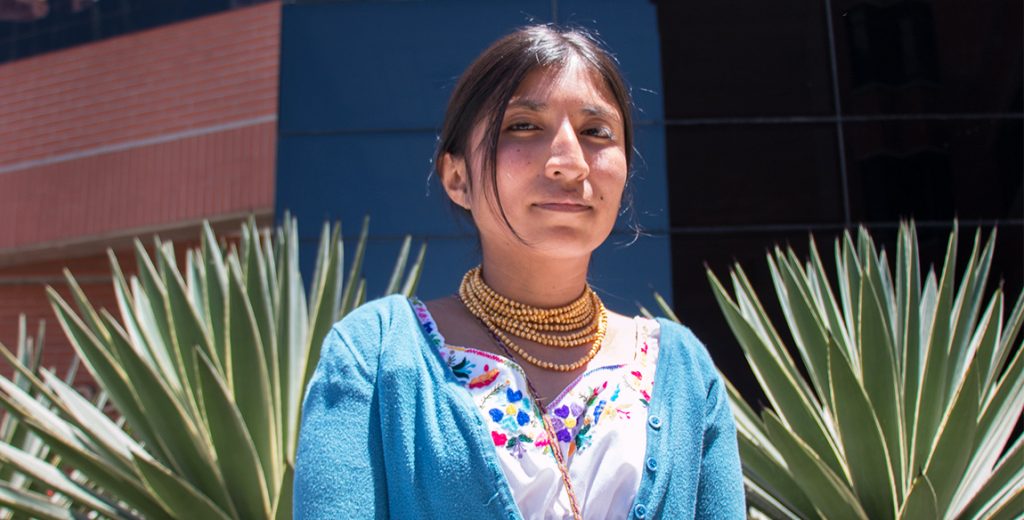“Inclusive and sustainable cities” were among the sexy buzz words that echoed through the UN’s conference chambers last week during its third global conference on urban development in Quito, Ecuador. Hundreds of national delegations, mayors and leading experts in architecture and urban planning from 167 countries gathered in the Andean city to formulate new cures for the all-too familiar problems of poverty and exclusion that plague a growing urban world.
To build inclusive cities, U.N. Secretary-General Ban-Ki-Moon said in his inaugural speech on October 17, means “engaging women and girls in making towns and cities safer and more productive for all.” But just a stone’s throw away from where the official raised the need to include and engage women, a protest march led by indigenous women and girls were welcomed with daunting barricades of riot police.
The march came out of parallel events organized by local and international grassroots organizations for land and housing rights that claim to defy the U.N’s Habitat III Conference. Organizers say they resist the U.N. for its “alliance with the multinationals they need for their investments” and for neglecting the countryside as a healthy and important living space.
Remezcla spoke to four indigenous woman activists – Aymara, Huaorani, Kichwa and Kitu Kara – to learn about the threats they face by and in the city, and how they fight to survive the urban world in the face of discrimination and erasure.
1
Hueiya Alicia Cahuiya Iteca
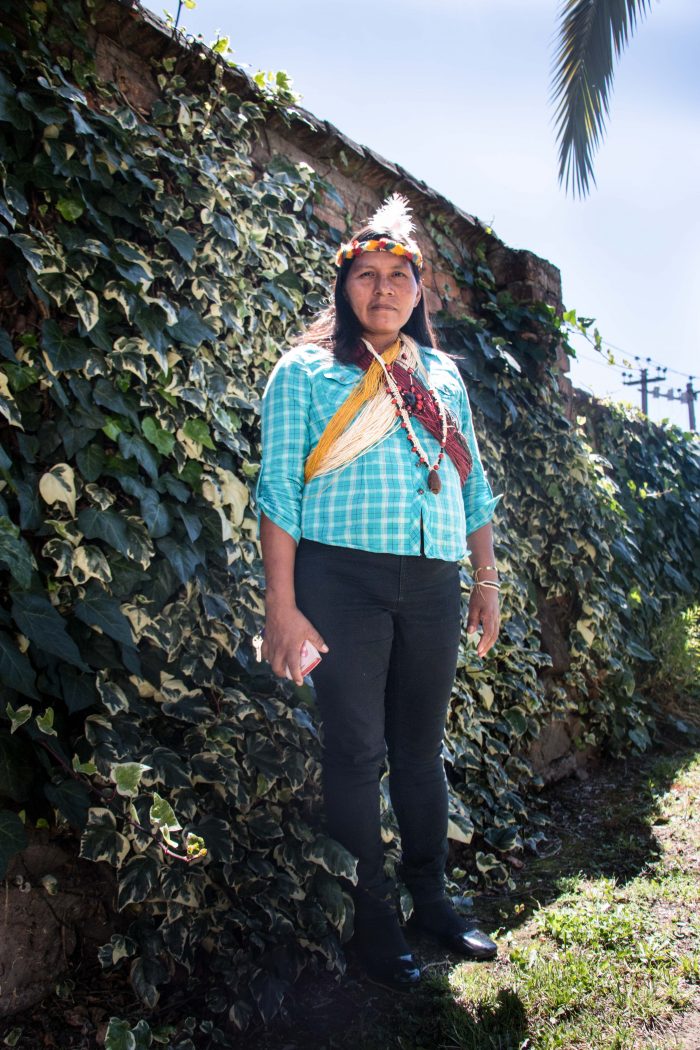
Age: 39
Title: Vice-president of the Organization of the Huaorani Nation of Ecuador
The United Nations should have invited us. It would have been important to participate in Habitat because of the subject of oil, women, development, water, climate change. But only those that belong to the government talk. Why not include ancestral people and communities? We also need to talk about what’s happening and they don’t take us into account.
I was 16 years old when I saw roads being built for oil companies to get into our territory (Yasunidos, Ecuadorian Amazon). They were building huge roads, shrinking our territory, and chopping loads of trees. That’s when I started to get concerned and to ask my grandmother: ‘Why are we letting them do this?’ My grandmother led me all the way. She said look, you have to defend the forest.
Before, I was part of ONHAE (Organization of the Huaorani Nation of the Ecuadorian Amazon). But there, only men decide and women are silenced. Seeing that no one was doing anything, I created a women’s organization so that we can decide. Because us women, we can do this. After all, we are the ones who cultivate the land, that share with the plants, that share the ancestral medicine.
Related: Latin America is the Most Dangerous Place to be an Environmental Activist
It hurts us to see our land like this, opened up. It’s a great disaster for us. So we told ourselves, if we don’t do anything, this will continue. Then we started to organize empowerment and consciousness-raising workshops for women everywhere across the two provinces of this territory: Pastaza and Orellana.
Then, out of nowhere, wood companies came into our territory. So I went out to defend. They wanted to take out all of the wood, but we wouldn’t let them. We managed to stop the incursion and the companies left.
This government must understand that we – Waorani and Tarmonani brothers – have fought for the defense of this territory. But the same government has not respected this because it continues to extract oil. We need to live from this territory, not from oil. What development has the government given us in exchange for oil? In exchange for oil, they left us death. Contaminated rivers. New diseases, such as cancer. That’s what they left us.
They have promised us education in exchange for oil. But our education is different and even better than the one from outside. The shamans are those who teach us and we have our own Indigenous Cosmovision, our own education, our own development, our own medicine. We have our own way of doing things. This is why, I Alicia, have always been defending. How can I allow them to kill all the rainforest, all the people who live here? New generations are adding to the forest but we haven’t killed it like the oil companies, or the very state. We have taken care of it. Because the shamans, the curanderos, the wise women of the forest, they share this forest and we live with this forest. That’s what we want.
2
Cecilia Flores
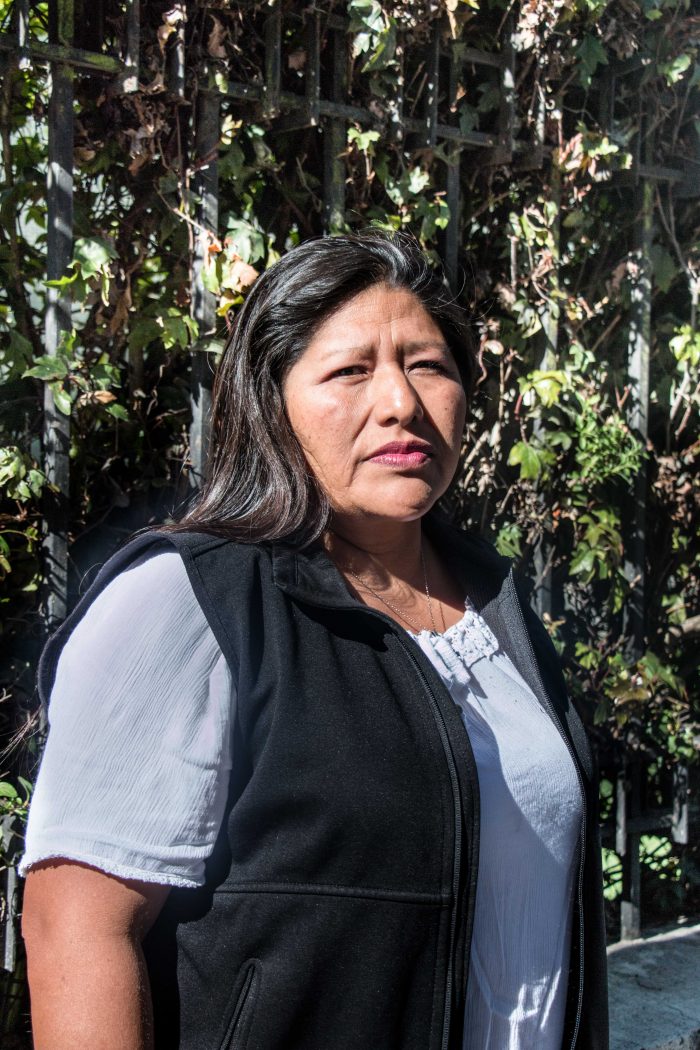
Age: 48
Title: Social Leader Representative of the Aymara People, Chile
We asked for a space at the UN Habitat III months ago. We had a meeting with the UN, during which we raised the issue of indigenous migration to the city. We thought it was important to visibilize this issue so that there’s support and solutions for indigenous people living in the city. They agreed it was important but said it wasn’t possible.
The other day I passed by the Habitat conference, and there was a stage with indigenous people dancing. The only thing we are useful for, to them, is entertainment. But we aren’t given a space to actually talk about the problems we face in the city.
Mining, oil and hydroelectric power projects have motivated incursions into indigenous territories. They tell us it is necessary for the country’s development even if it doesn’t follow our indigenous vision of development. When we protest, in some cases for years, the state just continues with its development plans anyways.
This forces migration to the city. While in the countryside we live el buen vivir – we aren’t stressed, live with family, share, work, have time to relax – in the city we work twice as hard, earn little, live in tiny spaces and face discrimination. We do not have a good quality of life.
In the city, our children assimilate to become accepted by society. With this comes the loss of cultural identity. Our children do not want to speak our language or wear traditional clothes because there’s discrimination and feelings of shame. This is troubling because we, as mothers, want our children to follow our heritage, our customs, our Cosmovision. But they no longer accept it.
I think it’s important that indigenous youth look for other indigenous people and get together in a communal space to reinforce their identity. There is a saying that goes: if one migrates to another place, one should never forget one’s roots. This is very important. It’s true that we leave el pueblo but we cannot lose this connection. We need to return once in awhile because nature renews you as a person. The city wears you out, drains your energy.
Young people have to do this, become closer to the family, not segregate themselves, and find that connection. Because it’s a way to value yourself: to have identity, have roots. They might not see that right now because they are distracted by all the things that are in the city. They forget about their parents, they lose their sense of community and become individualists. But with time they start valuing who they are, where they come from. It’s a source of strength that they cannot lose.
3
Manai Kowii
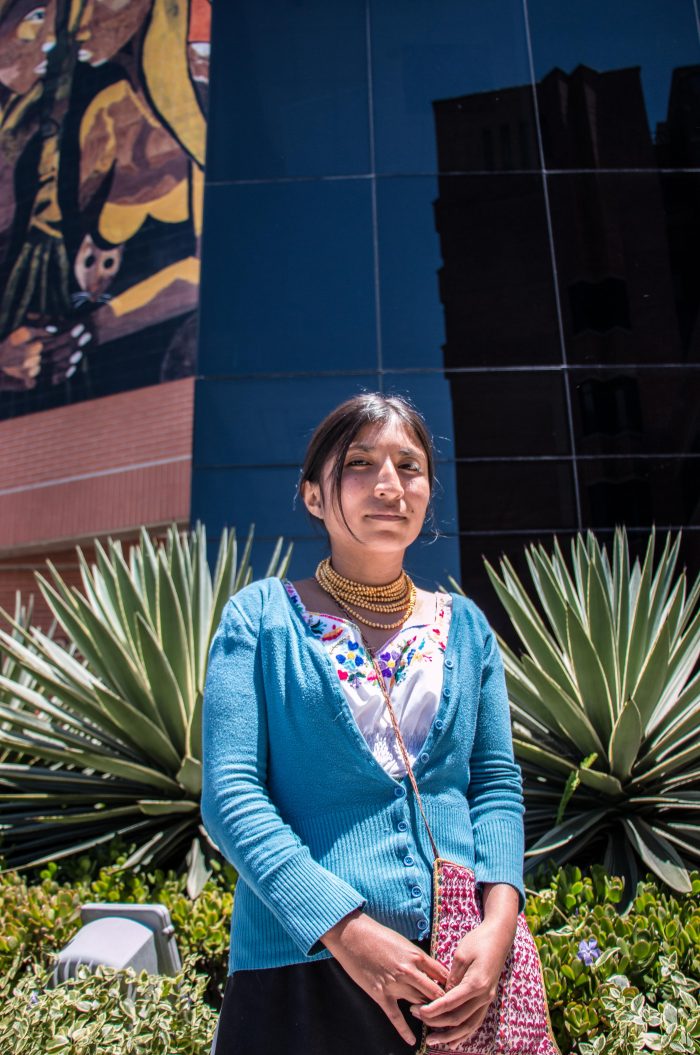
Age: 26
Title: Kichwa Visual Artist from Quito and Cotacachi
I have managed to navigate between Quito, Otavalo and Cotacachi. Being between these three different places has allowed me sustain ties with the culture. We’d go to the celebrations of Inti Raymi or the Day of the Dead. I’d see what my grandparents were doing and that has allowed me to learn from the culture. But living in Quito also gives you another perspective. Like there are topics that there you cannot touch, that are taboo. So it broadens your horizon.
Of course, living in Quito has also made Spanish the language that I use most. At school I didn’t have indigenous friends, so the city can also create conflicts with identity. Out of that desire to adapt to the city, a lot of people start to abandon elements of their culture. You see kids that do not speak the language or in the case of men, having conflicts over cutting their pony-tail because they get bullied.
A lot of young indigenous people have been looking for meeting spaces because they felt lonely in the city. Out of that necessity various collectives emerged. Our art collective, Sumakruray, is one of them.
Related: We Talked to 5 Young People About What Their Indigenous Identity Means to Them
When we got together we started to talk about Kichwa art. We raised questions like what do we think about Kichwa art? Do we agree with conventional definitions of Kichwa art beyond the artisanal and folklore? Why are we defined as “folk art”? These are ways of limiting ourselves without taking into account our necessities, our realities.
So we began to criticize European art and the way its artistic proposals have positioned themselves over indigenous ones. To criticize that they undervalue us, that they don’t understand the cultural wealth the artistic proposals of indigenous people offer.
I believe in the form of representing the indigenous and I think a lot of indigenous artists question how it has been exoticized and the way indigenous have been represented. In the Indigenismo movement, for example, what’s portrayed is oppression, suffering, sadness, anxiety.
We no longer represent that. Now it’s jubilation because if you only look at how colonialism has acted, you cannot see how indigenous people have created ways to break with that coloniality.
4
Rocio Gomez
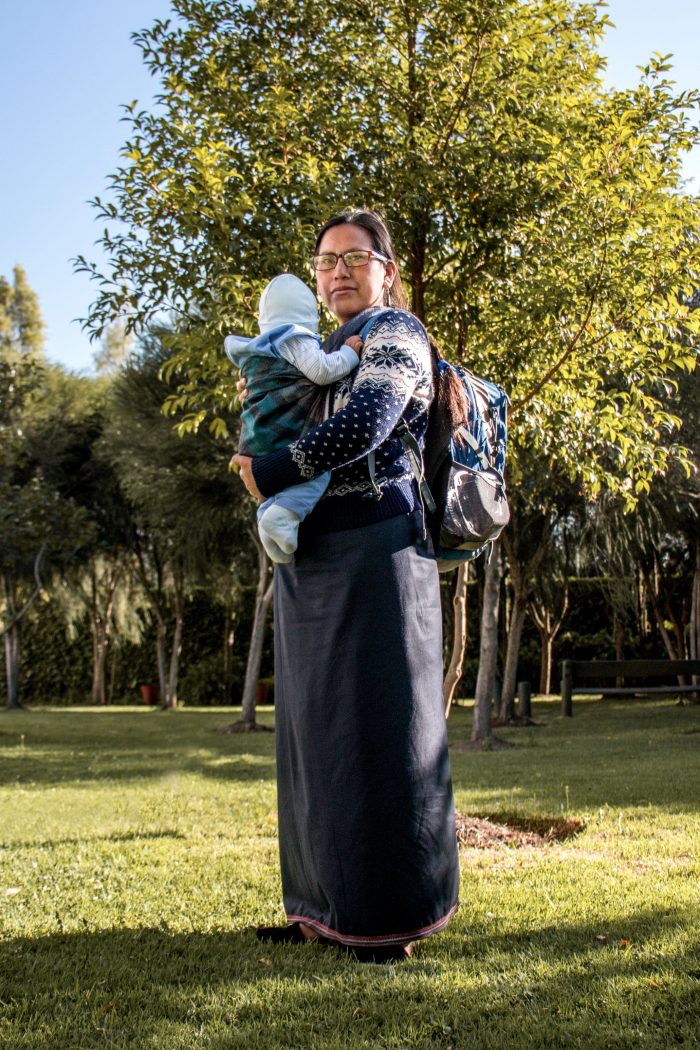
Title: Filmmaker Kitu Kara, original indigenous people of Quito
As a people that live here in Quito, in the capital, we are in danger of extinction. The last census of 2010 says we are 2,300 that recognize ourselves as Kitu Kara. Although other data says we are between 80,000 and 100,000.
I am thirty-something and I only started to recognize myself as part of this original indigenous people ten years ago.
We always lived the heritage from my mother’s side. She always taught us that we are indios. Not indigenous, indios. It was entering that phase from youth to adulthood — that time of personal exploration — during which we got to know that this pueblo existed. That’s where I started to tie my audiovisual work with being Kitu Kara and the necessity to tell myself from within – and to tell ourselves from within – our story. This was the process of recognizing ourselves as part of an ancestral people that has always been here but until now is invisibilized.
Related: College Students From Around the U.S. Are Gathering to Celebrate Quechua Language & Culture
This is because the city has lived a rapid process of urbanization and blanqueamiento (whitening); the denial of belonging to ancestral people. I understand this, it’s justified. My last documentary recounts this. Why, during that process my father experienced, he stopped recognizing himself (as Kitu Kara). He has his mother, or mother-in-law, his family, very clearly indigenous – even with the clothes and language – but he decides to no longer continue it. And then it’s no longer passed down to us. He went from being mistreated in the haciendas to being a jornalero in the city. What he has said is that he didn’t want us to go through the same experience.
For all of us, in general, we need to engage in a process of healing. I think we have a lot of resentment towards everyone, everything, because of what we have experienced: the colony, the conquest. Possibly it has stayed in us through the genes. But since the first conquest arrived, the Incas, we lived and survived that. The Spaniards arrived and we survived that. Then comes this new era of modernity and we continue here. I think that’s why, beyond resistance, what arises is rather a need for transcendence. So our process was to understand this, to recognize that we have lived tough times and if we don’t recognize that…I don’t want my son to grow up in that idea of pain. I want him to recognize himself with dignity. Indigenous, but indigenous with dignity and that yes, I have a story, but that it’s not a weight. I think that is what will allow us to walk and continue being happy.




